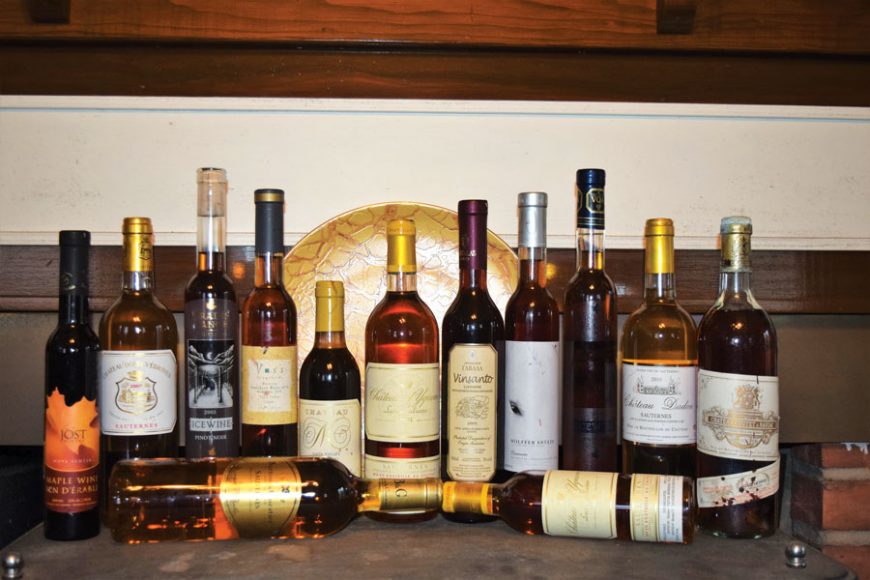I was invited to a small dinner party recently by some longtime friends. I asked what I could bring and was told, “Oh nothing, we are all set.” “Well, I’d like to bring something.” The hostess said, “If you think of something inspiring, you could bring a dessert.” And that got me thinking. I took a stroll down into my modest wine cellar and struck gold. I have been collecting dessert wines for some time now and have put down a couple dozen bottles, mostly in the 375 ml, half-bottle size. Many of these wines have been there for a decade or two and the color has deepened into a dark honey glow. So I picked out a few bottles that looked perfectly optimal and chilled them a bit.
There are many styles of wines from all over the world suitable to pair with dessert. Champagne, Franciacorta or any other well-made sparkling wine is often a good option. Rieslings, Gewürtztraminers, Moscato d’Astis, will all be fitting and appreciated. But there are wines that are specifically made to be sweet to accompany post-dinner conversation. There are many methods to create a sweet wine, short of adding sugar. Stopping fermentation at some point, that is, arresting the conversion of sugars into alcohol when the desired level of sweetness is achieved is one quick and easy method. But there are other techniques. Some regions like Sauternes in southern Bordeaux and the Vin Santos of Tuscany have created a style other regions try to emulate.
The first thing that has to happen in the winemaking process is to concentrate flavors by reducing liquid content of the grapes. This is achieved by sun drying them on mats or in boxes, letting the grapes freeze on the vines and encouraging botrytis, known as the noble rot, to dessicate the grape. In the Sauternes region, some of the most elegant and expensive dessert wines are crafted. Semillon, Sauvignon blanc and Muscadelle grapes can vary widely, but when supportive weather patterns fall into place, a perfect storm of botrytis fungus will emerge and will attack and shrivel the grape clusters.
These twisted and distorted clusters will then be crushed, fermented and oak-aged. The resultant volume is but a small percentage of the wine unaffected grapes will produce, which creates a steep price point. But the wines of Sauternes can be epic. Concentrating the juice does more than just saturate flavors. It creates a lingering mouthfeel unique in the world of wine. This oily and slippery, unctuous texture allows for a long finish of sweetness dancing on the tongue. The Tokaji region of Hungary, Napa Valley, Germany and the Finger Lakes region of New York state all predictably have weather conditions to support botrytis and this style of wine. Wolffer Estate on Long Island, in some vintages, makes a truly wonderful botrytized Chardonnay.
Ice wines, Eiswein in Germany, are wines created after the grape clusters freeze on the vines or are harvested and allowed to freeze in baskets or boxes. The grape skins fracture and spill some juice. This will concentrate flavors and create a similarly unctuous textured wine as in Sauternes. Sometimes grapes are left for the first freeze to create an ice wine. The harvest is often done in the middle of the night well before the morning sun warms the clusters. And sometimes, an early winter blast and a shortage of help prevents the complete harvest of the vineyards. What to do with shriveled grapes? “Hmmm. I think I will make some ice wine.” While there are many fine examples from Germany, all Canadian provinces make ice wines as well. Inniskillin of Ontario and Jost Vineyards of Nova Scotia are both well-made and worthy.
Passito-style wines originated in Italy, where the grapes were harvested and put on mats or in shallow boxes and allowed to sun- or air-dry to some level of raisin. The clusters are then pressed and fermented and then oak-aged. On a trip to Chianti Classico in Tuscany several years ago, I discovered Vin Santo, or Wine of the Saints. This Passito-style wine is put in small oak or chestnut casks and aged, often in attics that can get very hot in the summer and very cold in the winter. Many producers will age their Vin Santo for four or more years. Some of the wine evaporates through the wood. This is known as the angel’s share. With some air introduced into the cask, some oxidation will result.
I visited Fontodi winery in the Chianti Classico region. Giovanni Fontodi gave me a wonderful tour of his beautiful and biodynamic estate and led me to a tasting room. His wines are great, but his Vin Santo really got my attention. The grapes are harvested and naturally dried for five months in baskets. Their annual production is small at only 4000 half-bottles and, like all the Vin Santo producers we met, it is not a money maker. Still, Fontodi is proud of his Vin Santo. His is considered among the best. “We make it for our family and we sell the rest. If we stopped making it, my mother would kill me,” he says. With dried fruit flavors, apricots, dates and orange peel with honey, it will keep everyone’s attention well after the food is done.
So that was dessert. I brought an ice wine, a Sauternes and a Vin Santo. I also brought a bit of Roquefort cheese, some dried fruits, some nuts, a baguette and all were happy. Any well-stocked wine store should have many options when exploring dessert wines. Look for them and see if a particular style appeals to you more than others. These wines will turn any dessert into an experience to savor.
Write me at doug@dougpaulding.com.


